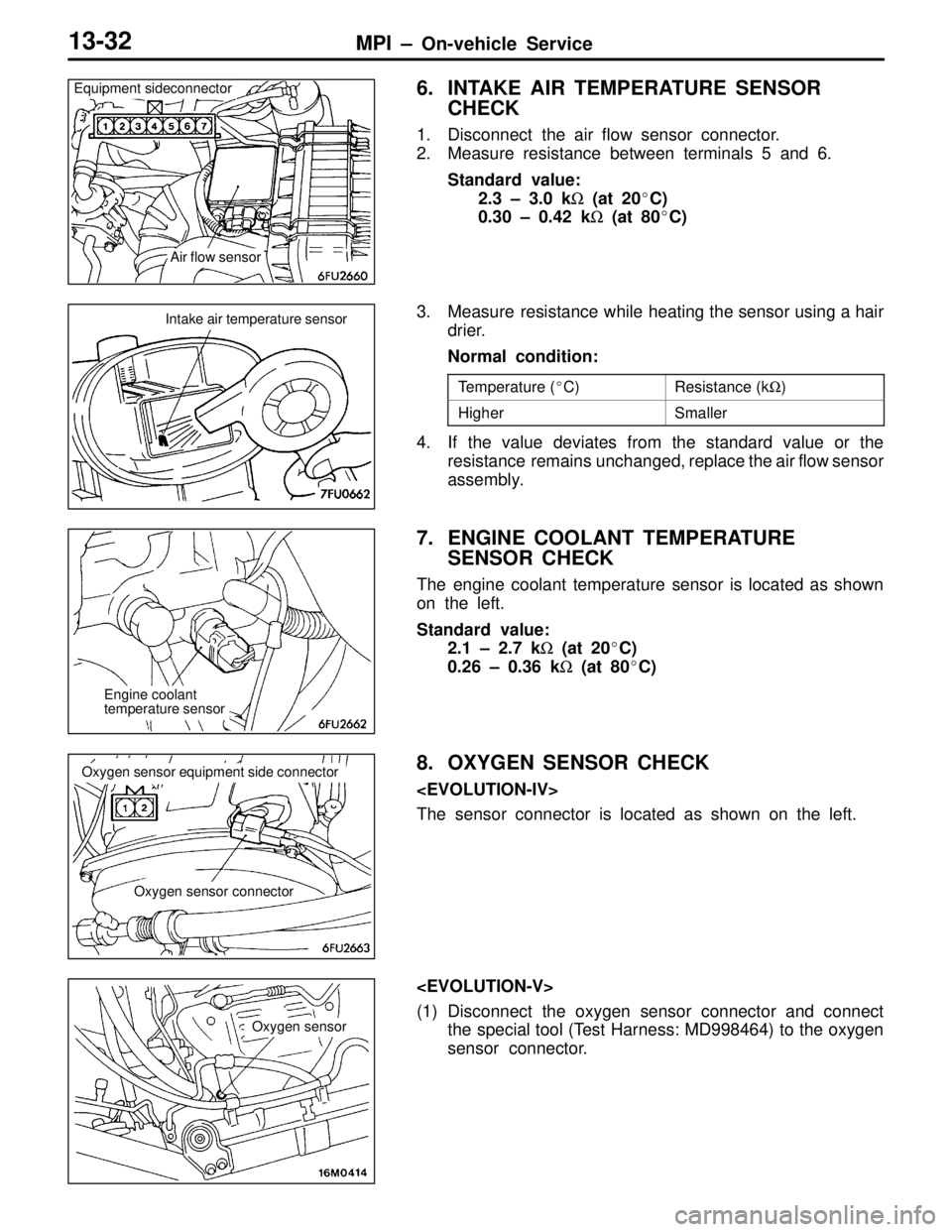Page 72 of 396

MPI – Troubleshooting13-29
The injector power supply voltage waveform shows a voltage drop caused by resistance of the resistor.
As the amount of current increases, voltage gradually decreases and a spike occurs at the plunger fully
opened position due to counter emf.
Point A: Voltage drop during fuel injection time (Refer to abnormal waveform example 1.)
Difference from standard waveformPossible cause
Voltage drop during fuel injection time is small (there
should normally be a voltage drop of about 10 V).Resistance of resistor is too small. Resistance of injector
is too large.
Point B: Spike when plunger is fully open (Refer to abnormal waveform example 2.)
Difference from standard waveformPossible cause
No spike when plunger is fully openPlunger inoperative
�Example 1
[Cause of problem]
Resistance of the resistor is too small.
[Waveform characteristics]
Small voltage drop
�Example 2
[Cause of problem]
Plunger is inoperative.
[Waveform characteristics]
No spike when plunger is fully open.
7-4 IGNITION COIL
Perform the same steps as with the conventional 4G9 engine
for the inspection.
Abnormal waveform
Normal waveform
Page 74 of 396
MPI – On-vehicle Service13-31
5. MPI SYSTEM COMPONENTS LAYOUT
NameSymbolNameSymbol
A/C switchQExhaust temperature warning lampS
A/C relayHFuel pressure control valveA
Air flow sensor (with a built-in intake air temperaturesensor and barometric pressure sensor)FIgnition coil and power transistor unitLsensor and barometric pressure sensor)InjectorB
Camshaft position sensorMISC servoD
Control relay and fuel pump relayPOxygen sensorK
Coolant temperature sensorEPower steering fluid pressure switchI
Crank angle sensorJSecondary air control solenoid valveN
Detonation sensorCThrottle position sensor (with a built-in idle switch)D
Diagnosis connectorR
Engine ECUOVehicle speed sensorT
Engine warning lampSWastegate solenoid valveG
Page 75 of 396

MPI – On-vehicle Service13-32
6. INTAKE AIR TEMPERATURE SENSOR
CHECK
1. Disconnect the air flow sensor connector.
2. Measure resistance between terminals 5 and 6.
Standard value:
2.3 – 3.0 kΩ (at 20�C)
0.30 – 0.42 kΩ (at 80�C)
3. Measure resistance while heating the sensor using a hair
drier.
Normal condition:
Temperature (�C)Resistance (kΩ)
HigherSmaller
4. If the value deviates from the standard value or the
resistance remains unchanged, replace the air flow sensor
assembly.
7. ENGINE COOLANT TEMPERATURE
SENSOR CHECK
The engine coolant temperature sensor is located as shown
on the left.
Standard value:
2.1 – 2.7 kΩ (at 20�C)
0.26 – 0.36 kΩ (at 80�C)
8. OXYGEN SENSOR CHECK
The sensor connector is located as shown on the left.
(1) Disconnect the oxygen sensor connector and connect
the special tool (Test Harness: MD998464) to the oxygen
sensor connector.
Equipment sideconnector
Air flow sensor
Intake air temperature sensor
Engine coolant
temperature sensor
Oxygen sensor equipment side connector
Oxygen sensor connector
Oxygen sensor
Page 76 of 396

MPI – On-vehicle Service13-33
(2) Check that there is continuity (11 to 18 Ω at 20�C) across
terminal no. 1 (special tool red clip) and terminal no. 3
(special tool blue clip) of the oxygen sensor connector.
(3) If there is no continuity, replace the oxygen sensor.
(4) Run the engine until the engine coolant temperature
exceeds 80�C.
(5) Using jumper wires, connect oxygen sensor terminal no.
1 (special tool red clip) and terminal no. 3 (special tool
blue clip) to battery (+) and (–) terminal, respectively.
Caution
Make sure of the correct connections: if a wrong
connection is made, a broken oxygen sensor results.
(6) Connect a digital voltmeter between terminal no. 2 (special
tool black clip) and terminal no. 4 (special tool white clip).
(7) Race the engine repeatedly to measure the oxygen sensor
output voltage.
Standard value:
EngineOxygen sensor
output voltageNOTE
When
engine is
raced0.6 – 1.0 VWhen engine racing is
repeated to enrich air-fuel
ratio, an operational oxygen
sensor should output a volt-
age of 0.6 to 1.0 V.
NOTE
Use the same procedures to remove and install the oxygen
sensor.
Red clip
Blue clip
MD998464
Red clip
Blue clip
MD998464 Black clip
White clip
Page 77 of 396
MPI – On-vehicle Service13-34
9. INJECTOR CHECK
Injection Condition Check
(1) Release the residual pressure from the fuel pipe line to
prevent fuel from flowing out.
(2) Remove the injector.
(3) Set up the special tools (Injector Test Set, Adapter, Fuel
Pressure Regulator, and Clip) as illustrated below.
(4) From here on, use the same procedure as with the
conventional 4G9 engine for the check.
MD998741
MD998706 MB991607Main hose
BatteryInjectorClip: MD998746Return hose
Fuel Pressure Regulator: MD116395
10. RESISTOR CHECK
(1) Disconnect the resistor connector.
(2) Measure resistance across terminals as detailed below.
Standard value
Measurement terminalsResistance (Ω)
1 – 3
4 – 3
5 5 to 6 5 (at 20�C)
5 – 3
5.5 to 6.5 (at 20�C)
6 – 3
Resistor
Page 79 of 396
MPI – Injector13-36
INJECTOR
REMOVAL AND INSTALLATION
Pre-removal Operation
(1) Fuel Discharge Prevention
(2) Air Hose D Removal
(Refer to GROUP15 – Intercooler.)Post-installation Operation
(1) Air Hose D Installation
(Refer to GROUP15 – Intercooler.)
(2) Fuel Leakage Check
O-ring
9 {0.9}83, 6
11
12
O-ring 10 – 13 {1.0 – 1.3}
Engine oil
1
2 3
4
5
6 78 9
10 11 12
Unit: Nm {kgf�m}
4
Removal steps
1. Injector connector
2. PCV hose connection
�A�3. High-pressure fuel hose connection
4. Fuel return hose connection
5. Vacuum hose connector
�A�6. Fuel pressure regulator7. Fuel return pipe
�A�8. Delivery pipe
9. Insulator
10. Insulator
�A��A�11. Injector
12. Grommet
Page 80 of 396
MPI – Throttle Body13-37
THROTTLE BODY
REMOVAL AND INSTALLATION
Pre-removal Operation
(1) Engine Coolant Draining
(2) Air Hose D Removal
(Refer to GROUP 15 – Intercooler.)
(3) Strut Tower Bar RemovalPost-installation Operation
(1) Strut Tower Bar Installation
(2) Air Hose D Installation
(Refer to GROUP 15 – Intercooler.)
(3) Engine Coolant Supplying
(4) Accelerator Cable Adjustment
34 2
61
7
19 {1.9}
5
Unit: Nm {kgf�m}
5 {0.5}
Removal steps
1. Accelerator cable connection
2. Throttle position sensor connector
3. Idle speed control servo connector
4. Vacuum hose connection5. Water hose connection
6. Throttle body
�A�7. Throttle body gasket
INSTALLATION SERVICE POINT
�A�THROTTLE BODY GASKET INSTALLATION
Place the gasket so that the projecting part is positioned
as shown in the illustration, and then install it between the
intake manifold and the throttle body.
Towards front
of vehicle
Up
Page 81 of 396
14-1
ENGINE
COOLING
CONTENTS
SERVICE SPECIFICATIONS 2. . . . . . . . . . . . . .
LUBRICANT 2. . . . . . . . . . . . . . . . . . . . . . . . . . . . .
ON-VEHICLE SERVICE 2. . . . . . . . . . . . . . . . . .
Coolant Replacement 2. . . . . . . . . . . . . . . . . . . . . .
THERMOSTAT 3. . . . . . . . . . . . . . . . . . . . . . . . . . .
WATER PUMP 5. . . . . . . . . . . . . . . . . . . . . . . . . . .
WATER HOSE AND WATER PIPE 6. . . . . . . .
RADIATOR 7. . . . . . . . . . . . . . . . . . . . . . . . . . . . . .